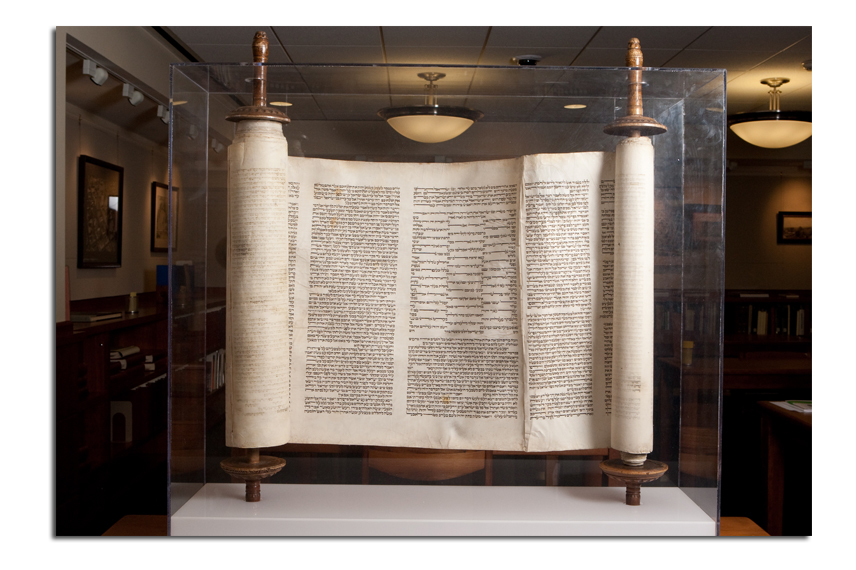The University of Houston (UH) is home to an impressive collection of rare books. Among them is Holocaust Torah No. 1518. UH has held the Torah, the holiest book in Judaism, since 1976, when it was obtained on behalf of the student body with the help of UH faculty and the Houston Jewish community.
 Until now, the Torah
has only been seen during Jewish holiday services. That will soon change when the
scroll goes on display in a new, specially designed plexiglass case, commissioned
by UH faculty, alumni, students from the Alpha Epsilon Pi fraternity and the
Houston Jewish community.
Until now, the Torah
has only been seen during Jewish holiday services. That will soon change when the
scroll goes on display in a new, specially designed plexiglass case, commissioned
by UH faculty, alumni, students from the Alpha Epsilon Pi fraternity and the
Houston Jewish community.
The dedication will take place at 4 p.m. Sept. 13 in the Evans Room (Rare Books) of Special Collections in the M.D. Anderson Library. Holocaust survivor, author and UH alum Celina Fein will share her Holocaust experiences during the dedication ceremonies. The event is free and open to the public.
Holocaust Torah No. 1518, said to be from the Pinkas Synagogue in Prague, is held under the protection of UH in agreement with the Memorial Scrolls Committee of the Westminster Synagogue of London, which gathered the Torahs after World War II and repaired the scrolls for safekeeping. While no one knows the exact age of No. 1518—it could be hundreds of years old— the history of the Torah dates back 2,000 years. It is not a printed document, but a scroll of 80 panels of parchment sewn together with animal sinew, constructed by highly qualified scribes through a painstaking, careful method. The scroll includes the five books of Moses.
“For the most part, it has been sitting in a box in the backroom of the Special Collections. It is important for something like this, which is really a living document for the Jewish community, to be seen as something that is appreciated.” said Rabbi Kenny Weiss, executive director of the Houston Hillel and adjunct faculty in the UH department of religious studies.
UH professor of English Irving Rothman, who studies rare books, was instrumental in the effort to bring the Holocaust Torah to UH more than 30 years ago. In 2012 he began the effort to commission the display case. Rothman said the Torah and other rare books in special collections— including an original copy of the King James Bible (1611) and the famous “Dictionary” by Samuel Johnson (1755)—are important tools to understand history.
“The Torah is really an impressive thing for students to see,” said Rothman. “They are able to see what a book would look like before printing when people had to inscribe each letter by hand. Because manuscripts were so difficult to compose and limited in quantity, very few could prepare them or read them. Even today, scribes are carefully trained and meticulous in their lettering of the Torah, and it takes special training to read it. But, of course, with the advent of the printing press, the Torah—the five books of Moses—has been printed in books and has become easily accessible to the total population.”
Torahs confiscated during the Holocaust were torn and mutilated. The Prague Holocaust Torah reveals multiple leaves with small and large patches, as well as new lettering inscribed according to tradition by a scribe so the Torah may be used in traditional services on campus. These repairs were done at the Westminster Synagogue in London. The Pinkas Synagogue was founded in 1352, with continuous worship until 1939, when the Nazis forbade divine service and closed synagogues during the occupation of Czechoslovakia.
The dedication of the Torah in its new display case will take place three days before the beginning of Rosh Hashanah.
What: Presentation of the Holocaust Torah in its Display Case, “The Holocaust Experience” presentation by Celina Fein, Holocaust Survivor
When: Thursday, Sept. 13, 4 – 5 p.m.
Where: UH M.D. Anderson Library, Evans Room of Special Collections (top of the 2nd floor)
Who: The event is free and open to the public